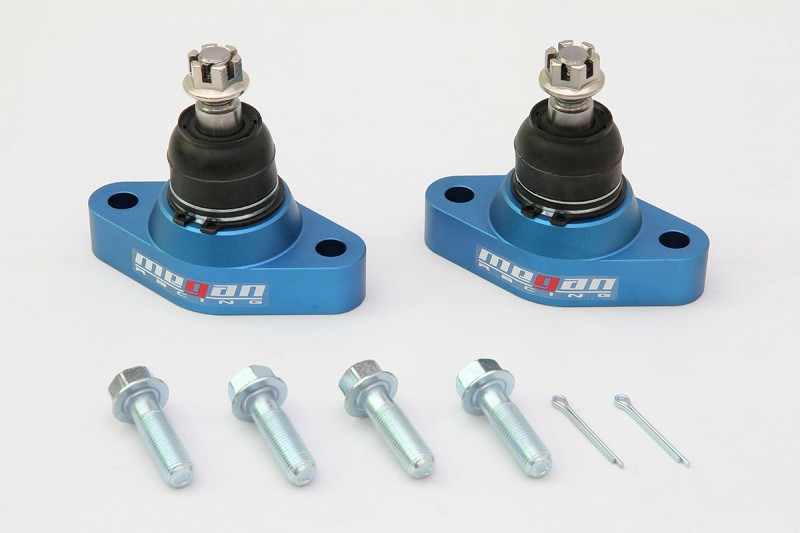S2000 Roll Centers
By Rob Robinette
How I Got Into the S2000's Roll Centers
I was having a problem with inside rear wheel lift/spin when powering out of slow to medium speed corners. The wheel would unload (lift) enough to open the stock Torsen differential and spin up the wheel allowing the engine to hit the rev limiter.
I was running KWV3 coil overs with 628 front and 571lb rear (110Nmm / 100Nmm) springs, Comptech adjustable front anti-roll bar at the 3rd stiffest position out of 5, and the stock 2001 rear anti-roll bar. My S2000 has a full cage with very little chassis flex. The car handled extremely well other than the wheel lift/spin problem. Only two S2000's have run 1:21 laps at Summit Point and my S is one of them.
I did the math and found:
Total Wheel Rates
Front 391 lb-in spring + 243 lb-in sway bar = 634
Rear 315 + 75 = 390
Front to Rear total wheel rate ratio: 1.62 Roll Couple Distribution
Rear to Front ratio = 61% Roll Couple Percentage
Roll Couple Percentage describes lateral load transfer distribution front to rear and subsequently handling balance. It is the effective wheel rate, in roll, of each axle of the vehicle as a ratio of the vehicle's total roll rate. Higher than 50% means the front wheels take more weight during cornering and the handling progresses toward understeer but for most cars around 60% gives balanced handling on the track and around 75% works for autocross.
I assume if both outside suspension arms compressed the same amount in a corner (equal chassis roll front and rear) then both inside wheels would remain equally loaded and in contact with the track (steady state).
With stiffer springs and anti-roll bar up front it seems if any of the tires would unload it would be the inside front because the outside rear suspension would compress more. This extra compression of the outside rear suspension would lift the diagonal wheel (front inside). Add acceleration and rearward weight shift and even more weight would shift off the inside front wheel.
But in actuality it appears chassis roll is causing the outside front suspension to compress more which allows the diagonal wheel (inside rear wheel) to be unloaded by the rear anti-roll bar and cause inside rear wheel spin. The diagonal wheel is affected just like a four legged table with one short leg--the leg diagonal to the short leg comes off the ground when the short leg is pushed down.
With a near 50/50 front/rear weight ratio and more spring and sway bar up front why would the front outside wheel compress more than the outside rear?
Short Answer: The S2000's center of mass over the axles is higher and the roll center is lower at the front of the car than at the rear. The front's greater distance between the center of mass and roll center (roll moment arm) gives centrifugal force a longer lever in which to roll the car in a corner so the front of the car rolls more than the rear. As the front of the car rolls more it compresses the outside front suspension more than the outside rear which allows the inside rear wheel to be lifted (unweighted) by the rear anti-roll bar. A contributing factor was the large amount of caster I was running. 7.5º of caster is high enough to cause the inside front wheel to jack and transfer weight from the inside rear to the outside rear which also contributed to unloading the rear inside wheel and wheel spin. Wider than stock low offset wheels can also increase the amount of caster weight jacking. I was running RPF1 17 x 9" +45 offset wheels.
This is also the reason a big-ass front anti-roll bar upgrade helps the S2000's handling so much.
Roll Center, Center of Mass and Roll Moment Arms
Our two axle Honda S2000 has two roll centers, one aligned over each axle. The roll center is the point the chassis rolls around when it leans around a corner. It's found by extending the axes of the suspension arms until they intersect. A straight line is then drawn from this point back to the tire's contact patch (see diagram below). The intersection of this line and the vehicle centerline is the roll center. When measuring or diagramming roll centers be sure and use the actual suspension pivot points (unlike the photos below). For the S2000 that's the inboard suspension arm bolts and the ball joint's ball pivot.
The center of mass is the "center of gravity" over each axle. For example a station wagon would have a higher center of mass over the rear axle than the front axle due to the high, heavy rear roof. It's easy to visualize a station wagon's rear rolling more than its front when going around a corner.
The distance between the roll center and the center of mass is called the roll moment arm (see diagram below). The greater the distance between the roll center and the center of mass, the longer the lever centrifugal force has to work with to roll the body. Think of the roll moment arm as a lever that runs upward from the roll center. Centrifugal force grabs the lever at the center of mass and pushes the lever toward the outside of the turn and rolls the chassis. The longer the lever the easier it is to roll the car.
Shortening the roll moment arm, by raising the roll center or lowering the center of mass, will reduce chassis roll. Taken to the extreme if the roll center and center of mass are in the same spot then the chassis will not roll when going around a corner.
When an S2000's suspension is lowered it's roll center is lowered more than the center of mass which increases the length of the roll moment arm which makes the car roll more than when running at stock height (assuming same spring rates). A roll center adjuster can be installed on the front lower control arm ball joints to correct the lower control arm's angle to raise the roll center to shorten the roll moment and reduce chassis roll. Sometimes suspension modifications can change the roll center. Because the ball pivot is extended to make room for the adjuster, SPC adjustable ball joints raise the roll center.
1 inch Lowered AP1 S2000's Rear Roll Center Approximately 6 Inches Off the Ground. The Center of Mass Shown Above is a Wild-Ass-Guess for Illustration Only. The Roll Moment Arm is the Distance Between the Roll Center and the Center of Mass Over the Axle
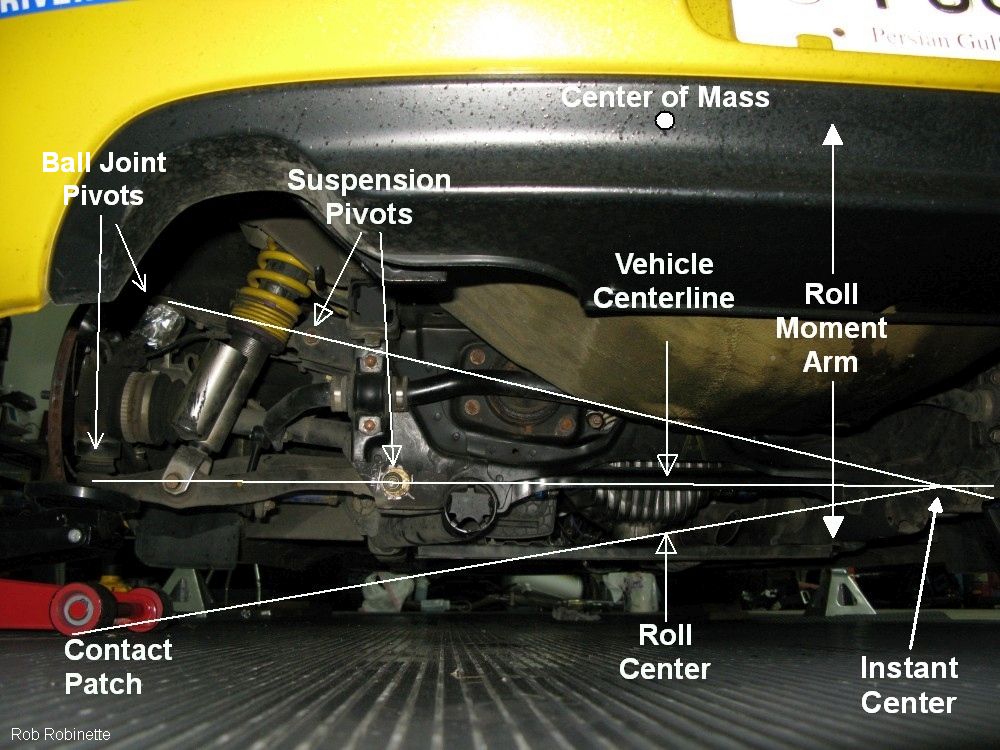
Draw an extended line from the upper ball joint pivot through the upper suspension pivot. Draw a line from the lower ball joint through the lower suspension pivot. Where the two lines meet draw a line back down to the tire contact patch. Where this line meets the vehicle center line is the Roll Center.
Again, think of the roll moment arm as a lever that centrifugal force uses to lean the car in a corner. The longer the lever the more roll. Raising the center of mass will lengthen the lever as will lowering the roll center. Lowering the car lowers both the center of mass and the roll center, but the roll center moves more than the center of mass which lengthens the roll moment arm. This is why it becomes an issue with lowered cars.
Bone Stock AP2 S2000 Rear
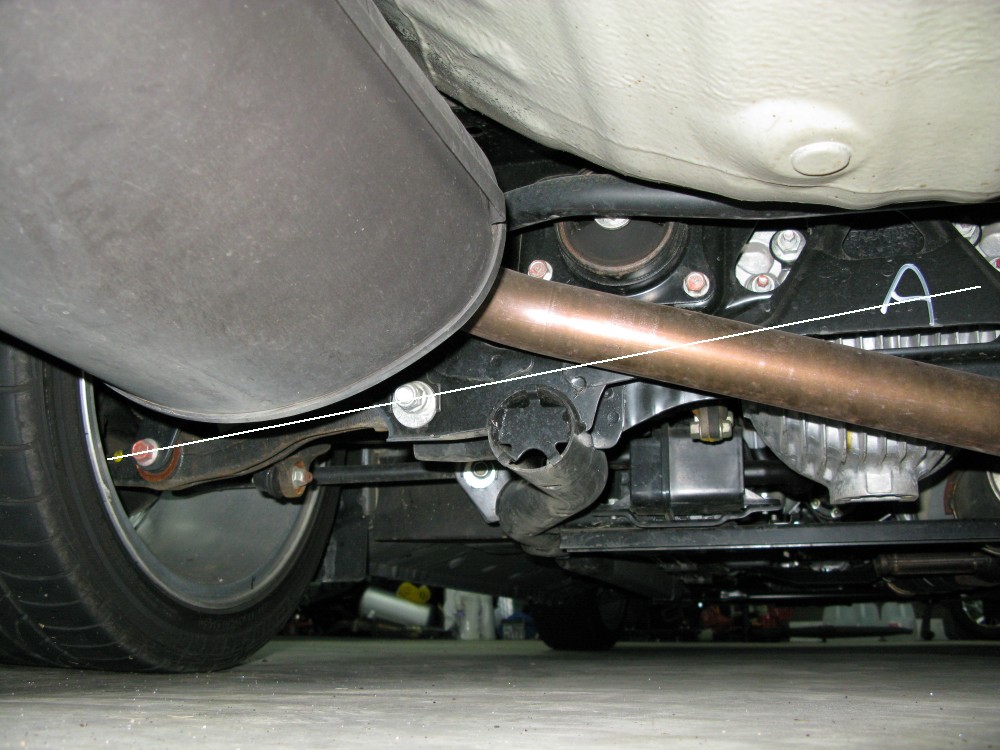
1 inch Lowered S2000's Front Control Arm Angles Before Roll Center Adjusters

1 inch Lowered with Roll Center Adjusters

1 inch Lowered S2000's Front Lower Control Arm
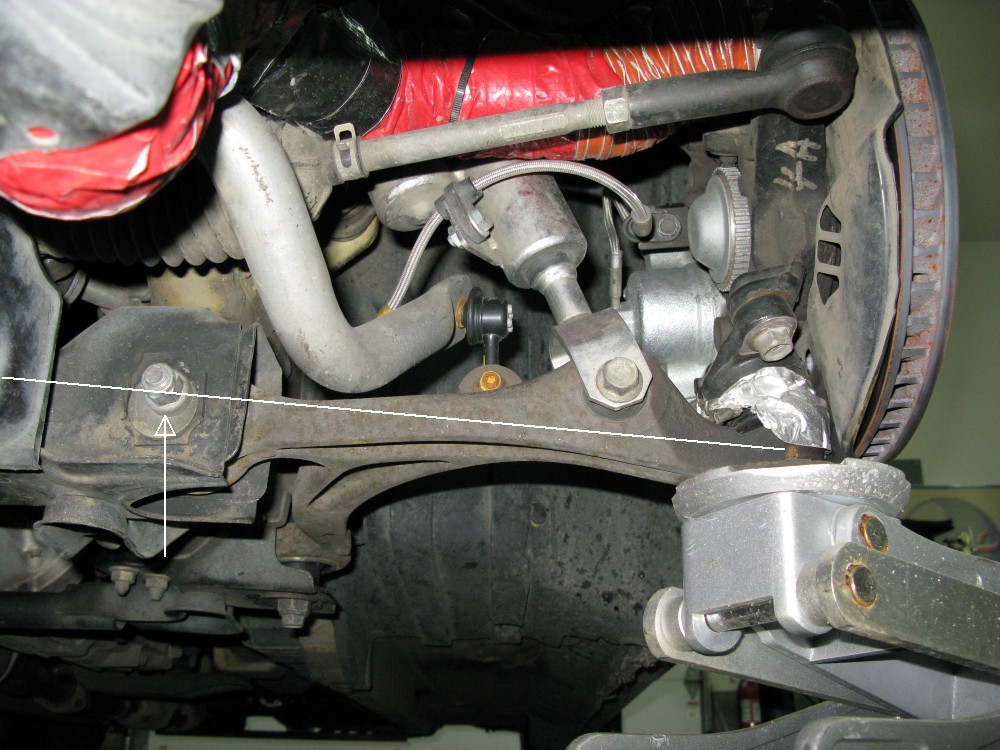
1 inch Lowered Front Lower Control Arm Angle with Roll Center Adjusters
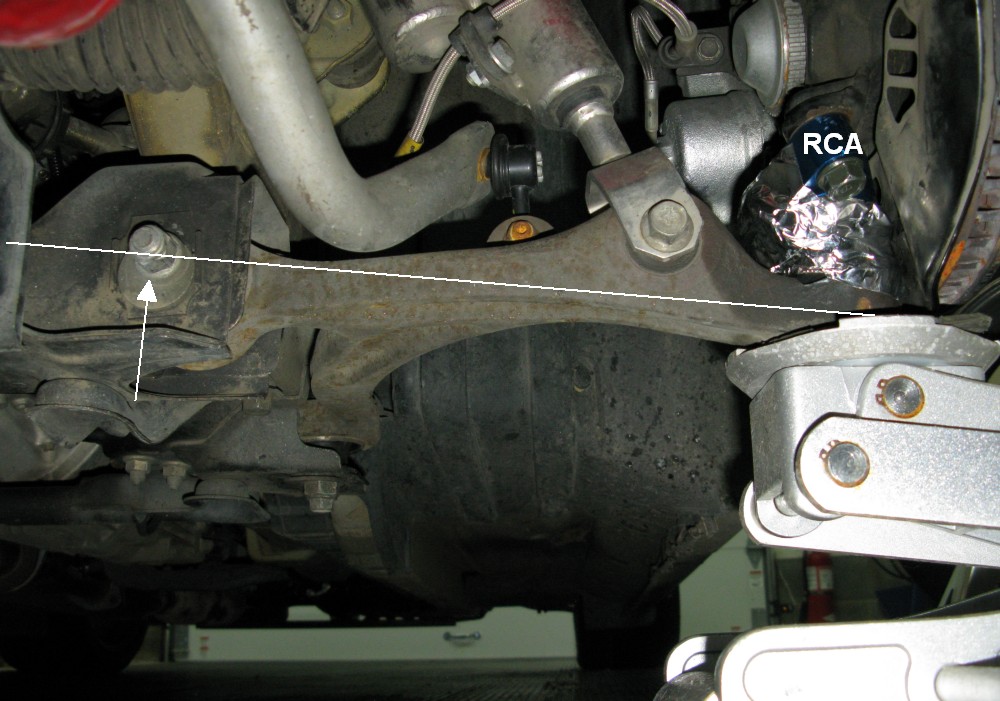
Stock AP2 S2000's Front Lower Control Arm Angle
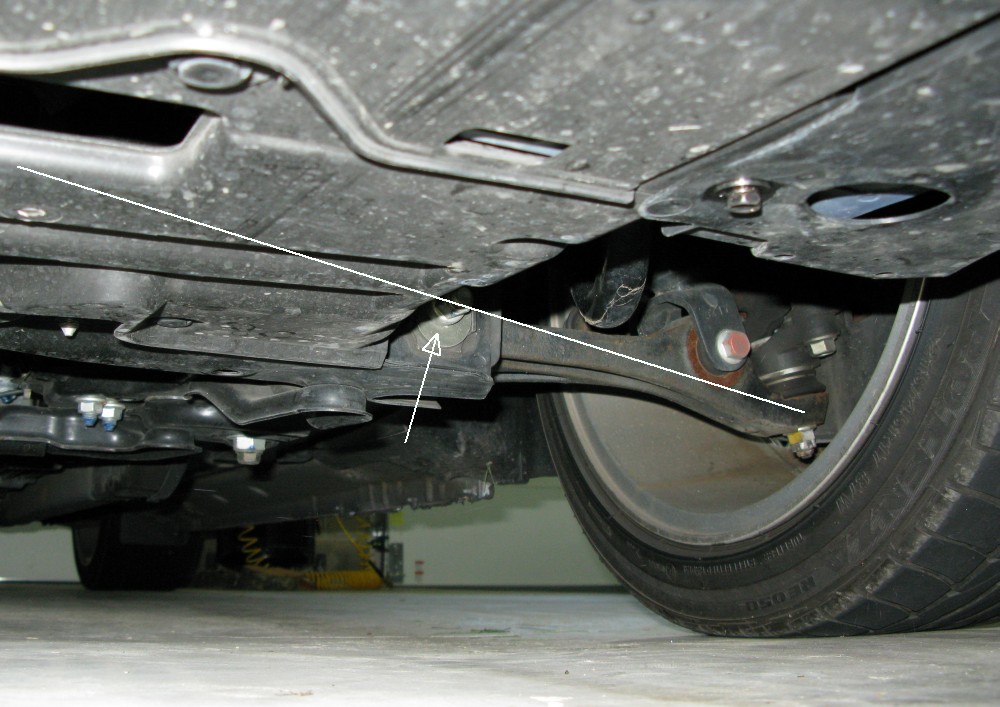
Megan Racing S2000 Front Roll Center Adjusters (raises roll center)
A is the Center of Mass Over the Axle, B is the Roll Center
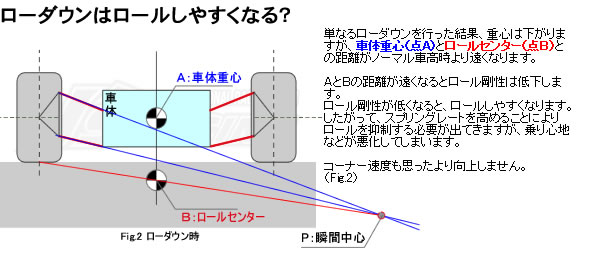
Same Lowered Car With a Roll Center Adjuster Installed to Correct the Lower Control Arm Angle and Raise the Roll Center Which Reduces Chassis Roll
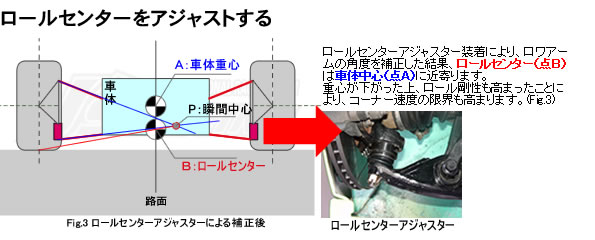
See this how-to for instructions on installing front roll center adjusters on the S2000.
